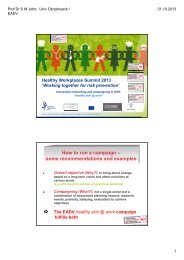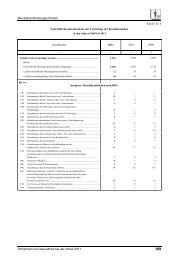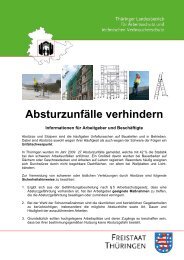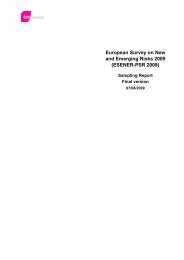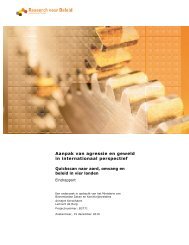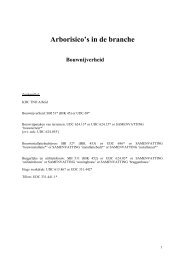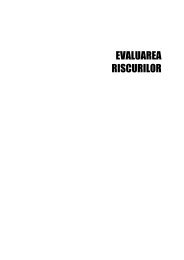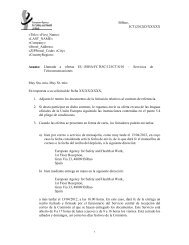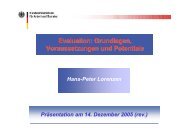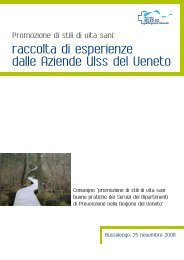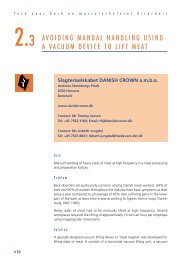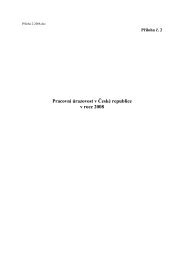Literaturzusammenstellung RSI-Syndrom - European Agency for ...
Literaturzusammenstellung RSI-Syndrom - European Agency for ...
Literaturzusammenstellung RSI-Syndrom - European Agency for ...
Erfolgreiche ePaper selbst erstellen
Machen Sie aus Ihren PDF Publikationen ein blätterbares Flipbook mit unserer einzigartigen Google optimierten e-Paper Software.
ND: 043714<br />
AU: McCauley-Bell, P.; Crumpton, L.<br />
TI: A fuzzy linguistic model <strong>for</strong> the prediction of carpal tunnel syndrome risks<br />
in an occupational environment<br />
TT: Ein Fuzzy-Modell zur Risikoprognose des Karpaltunnelsyndroms in der<br />
Arbeitsumwelt<br />
SO: Ergonomics<br />
CN: Z 504<br />
IM: 40 (1997) Nr. 8, S. 790-799 (2 Abb., 5 Tab., 7 Lit.)<br />
CT: Arbeitsbedingte Erkrankung; Risikoabschätzung; <strong>RSI</strong>-<strong>Syndrom</strong><br />
This research presents the development and evaluation of a fuzzy linguistic<br />
model designated to predict the risk of carpal tunnel syndrome (CTS) in an<br />
occupational setting. CTS has become one of the largest problems facing<br />
ergonomists and the medical community because it is developing in epidemic<br />
proportions within the occupational environment. In addition, practitioners are<br />
interested in identifying accurate methods <strong>for</strong> evaluating the risk of CTS in an<br />
occupational setting. It is hypothesized that many factors impact an<br />
individual's likelihood of developing CTS and the eventual development of CTS.<br />
This disparity in the occurrence of CTS <strong>for</strong> workers with similar backgrounds<br />
and work activities has confused researchers and has been a stumbling block in<br />
the development of a model <strong>for</strong> widespread use in evaluating the development of<br />
CTS. Thus this research is an attempt to develop a method that can be used to<br />
predict the likelihood of CTS risk in a variety of environments. The intent is<br />
that this model will be applied eventually in an occupational setting, thus<br />
model development was focused on a method that provided a usable interface and<br />
the desired system inputs can also be obtained without the benefit of a medical<br />
practitioner. The methodology involves knowledge acquisition to identify and<br />
categorize a holistic set of risk factors that include task-related, personal,<br />
and organizational categories. The determination of relative factor importance<br />
was accomplished using analytic hierarchy processing (AHP) analysis. Finally a<br />
mathematical representation of the CTS risk was accomplished by utilizing fuzzy<br />
set theory in order to quantify linguistic input parameters. An evaluation of<br />
the model including determination of sensitivity and specificity is conducted<br />
and the results of the model indicate that the results are fairly accurate and<br />
this method has the potential <strong>for</strong> widespread use. A significant aspect of this<br />
research is the comparison of this technique to other methods <strong>for</strong> assessing<br />
presence of CTS. The results of this evaluation technique are compared with<br />
more traditional methods <strong>for</strong> assessing the presence of CTS. (Nachdruck).<br />
ND: 043620<br />
AU: Snook, S.H.; Vaillancourt, D.R.; Ciriello, V.M.; u.a.<br />
TI: Maximum acceptable <strong>for</strong>ces <strong>for</strong> repetitive ulnar deviation of the wrist<br />
TT: Maximal zulässige Kräfte für wiederholte Drehbewegungen des Handgelenks<br />
SO: American Industrial Hygiene Association journal<br />
CN: Z 249<br />
IM: 58 (1997) Nr. 7, S. 509-517 (2 Abb., 13 Tab., 12 Lit.)<br />
CT: Arbeitsphysiologische Untersuchung; Hand-Arm-System; <strong>RSI</strong>-<strong>Syndrom</strong><br />
The purpose of this experiment was to quantify maximum acceptable <strong>for</strong>ces <strong>for</strong><br />
ulnar deviation motions of the wrist at various repetition rates. Subjects<br />
grasped a handle with a power grip and moved it through a 1.40 rad (80)<br />
ulnar deviation wrist motion (similar to a knife cutting task). A<br />
psychophysical methodology was used in which the subject adjusted the<br />
resistance on the handle and the experimenter manipulated or controlled all<br />
other variables. Two series of experiments were conducted. Thirteen subjects<br />
completed the first series, which investigated repetition rates of 15 and 20<br />
motions per minute. Eleven subjects completed the second series, which<br />
investigated 15, 20, and 25 motions per minute. Subjects per<strong>for</strong>med <strong>for</strong> 7 hours<br />
per day, 5 days per week, <strong>for</strong> 4 weeks in the first series and 5 weeks in the<br />
second series. The subjects were instructed to work as if they were on an<br />
incentive basis, getting paid <strong>for</strong> the amount of work they per<strong>for</strong>med. Symptoms<br />
were recorded by the subjects during the last 5 minutes of each hour. The<br />
______________________________________________________________________________________________<br />
BAuA-Literaturrecherche <strong>RSI</strong>-<strong>Syndrom</strong> (Stand August 2002) Seite 14 von 50



